As a company owner, you already know the importance of having a well-developed customer service system. Like most things in the business world, customer care has undergone significant changes. In the past, we used to rely on telephone calls that took too long to resolve. Luckily, much of that has been replaced with social media customer service.
Many businesses worldwide have started using social media platforms as their primary way of communicating with customers, answering their questions, resolving issues, assessing reviews, and so much more. You may have believed social media customer service is optional, but the digital world dictates otherwise — it’s more important than ever.
If you have yet to consider implementing social media customer service for your business, this is the perfect time. In this guide, you’ll learn the basics of using social media platforms to communicate with your customers, including practical techniques and real-world examples.
What is social media customer service?
Support service uses social media to resolve customer issues, answer questions, and receive feedback through various channels, including posts, direct messages, and comments. Still, this type of customer service is so much more than that.
As previously mentioned, businesses used to rely heavily on telephone channels to provide customer service. However, once social media started entering the scene, tools like direct messaging were used for communication, especially for addressing issues directly. Consequently, these systems were constantly upgraded to provide even more convenient tools for companies, making them a customer service norm.
In addition to direct messages, modern social media customer service now includes self-help channels and innovative chatbots designed to answer simple questions. With the rise of AI, these systems are expected to develop even further, ultimately improving the customer experience and service performance.
As a result, businesses that opt for social media customer service enjoy many benefits and elevated customer experiences. Due to the fast and personalized response, potential and existing customers are likelier to opt for your services (or use them again). These systems are also cost-effective and ideal for start-up businesses with strict budgets.
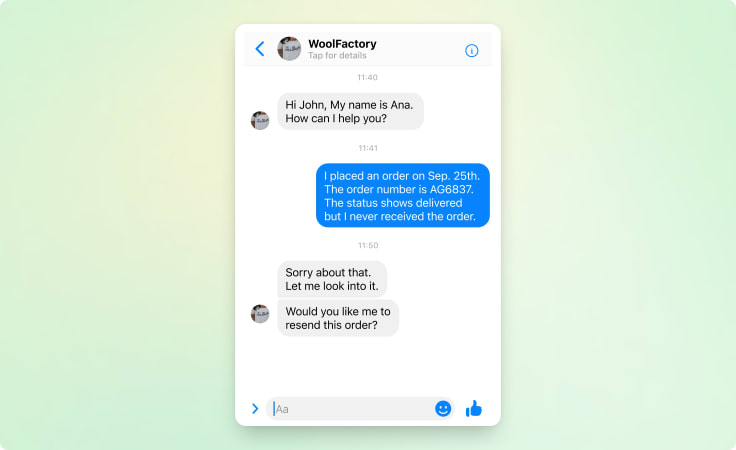
Benefits of providing social media customer service
Let’s review some of the best benefits of using social media platforms as your customer service channels.
Shorter waiting times
You may now realize why many businesses have turned to customer service on social media. However, it’s important to understand why it’s rapidly becoming a standard in the social customer service world. Namely, as these systems developed and became widespread, customer expectations changed drastically.
To clarify, we need to step back in time once again. All customer service questions, complaints, and messages were handled manually through the phone. Naturally, this included long waiting times paired with “elevator music,” which felt like torture after hearing it for so long. Glad we’re not on that page anymore!
Nevertheless, people had to explain their issues in detail, and a customer support team had to work their best to provide the best possible solution. While this may have contributed to a more personalized service, it took up a long time, ultimately creating additional costs.
However, this all changed with social media customer service. People now have access to many self-help channels and detailed FAQs, which can quickly solve their issues and eliminate the need to talk to customer service reps. In more severe cases, however, customers only have to access the business’s social media platform and use the chat to communicate with an agent. Not only does social media customer service streamline the entire process, but both parties have insight into the issue, meaning it can be handled swiftly and efficiently.
Still, while this has proven to be quite an effective strategy for all businesses, it also has drawbacks. Before, customers knew they had to wait a while for their concerns to be addressed. For that reason, almost 80% of millennials prefer to use social media platforms to voice their issues, knowing they will be answered promptly. Another statistic shows that 60% will favor social media customer service brands.
Knowing how many people rely on it, you must develop a system and team that efficiently meets customer expectations. In other words, if customers expect to be replied to within a day, you must make that happen.
Smaller costs
Did you know that social customer service can also save you money? For instance, the average call to a contact center costs about $6, whereas social media customer service averages $1.
Additionally, this may also cause further profit gain.
Elevated brand image
People love to be recognized, especially when it’s coming from their favorite brand. That said, if you engage with your customers in any way, be it by responding to their questions, commenting on their use of your service or product, or addressing customer complaints publicly, they will be more likely to come back to you and build a lasting and loyal relationship.
What’s even better is that potential customers will see how you handle concerns with a personalized approach, putting you steps ahead of your competition.
Handle all your customer communication in one simple dashboard. Configure HelpDesk on your social media channels. ☁️
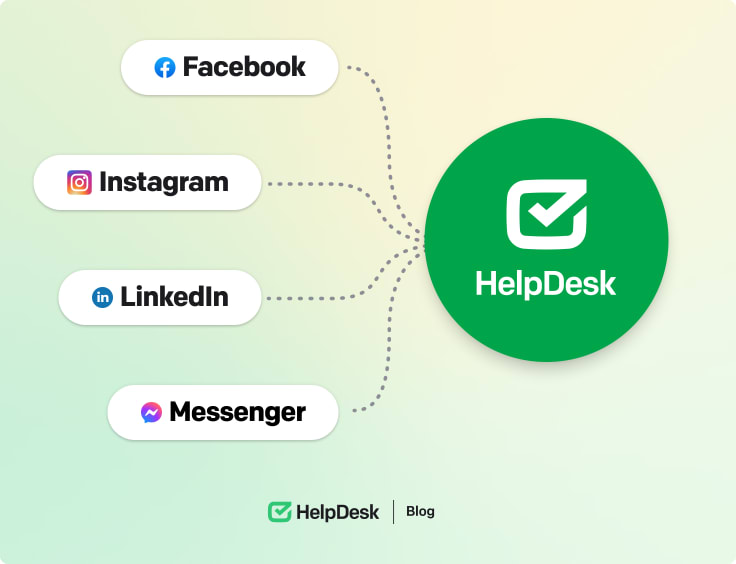
Building a strong customer service team
Even though social media customer service can be easily integrated into all kinds of businesses, you may need help finding the appropriate team responsible for it.
Since this process solely runs through social media platforms, the team already running the accounts is responsible for handling customer service requests. However, if your customer service team needs to learn how to address issues accordingly, you only harm your brand image in the long run. Luckily, this has been resolved with software and effective management, which we’ll get into shortly. For now, let’s focus on the facts.
The truth is that social media customer service may be assigned to anyone, from digital marketing and digital customer care teams to CX and social media teams. With the help of dedicated customer support channels and software, the team will know exactly which approach to use. Training also takes little time and is simple, meaning you don’t have to turn to other, more costly customer service forms.
Use a strategic approach and train your customer service team. 🚀Discover all the benefits of employee training with HelpDesk. 🔥
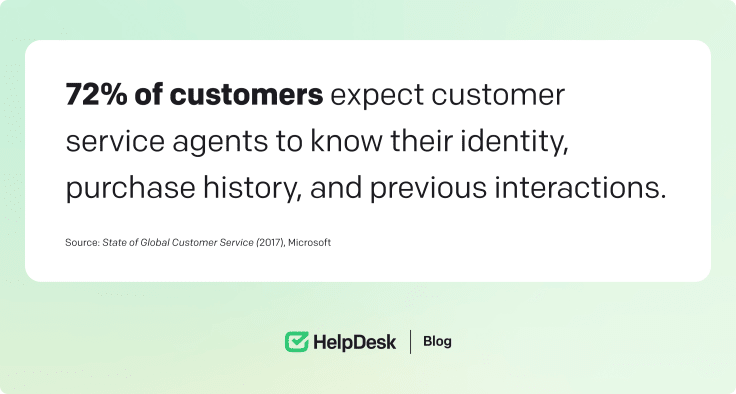
Creating an internal tracking system for customer service requests
So, what is the best way to ensure your social media customer service runs as efficiently as possible? It’s very simple — with the help of HelpDesk!
This desk system will answer customer messages swiftly and organize them neatly so the whole team can easily navigate them. Automating your workflow can be done in minutes, and you’ll be able to put messages from all your social media platforms in one place.
Undoubtedly, the integration of HelpDesk makes it a highly reliable social media customer service platform. The desk system can help you automate repetitive tasks, saving you much time. You can also create automated chatbots and contact forms, further helping you streamline the social customer service process.
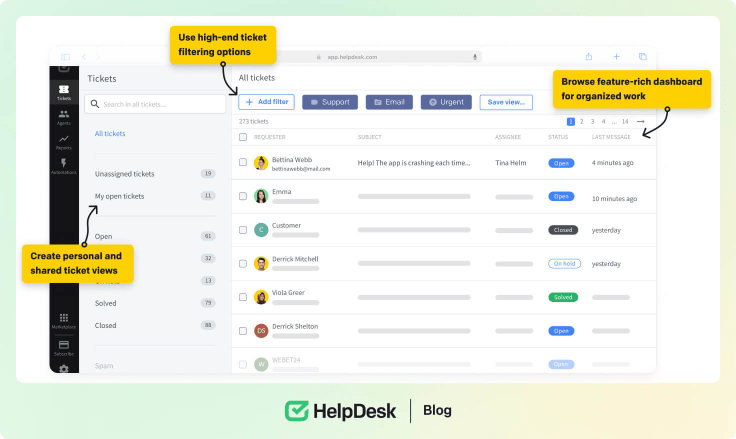
Documenting an escalation management strategy
There will be times when specific customer queries must be handled personally. In that case, your customer service team strategy needs to work like a well-oiled machine.
You’ve most likely encountered a situation where a customer is dissatisfied with your product or service and complains publicly on your social media posts. Although it’s advisable to address all kinds of feedback, even negative ones, you should navigate the customer to the appropriate channel where they can voice their concerns. From there, the appropriate customer service teams handle the issue.
In this process, the entire team must know their responsibility and role. For instance, if certain team members are responsible for answering customer messages through direct messaging tools, they’re forbidden from answering comments. Instead, they should direct the customer to the appropriate channel.
Choosing the most relevant platforms for your business
Establishing social media customer service is pretty simple, but how do you know which platforms to use for your business? New ones appear by the minute, which can pose a challenge if you follow trends. In this case, however, you should stick to your guns.
By this, stick to the social media platforms you already use, such as Instagram, Facebook Messenger, WhatsApp, etc. Setting up profiles on other platforms will take more time and effort and may need to be more successful in the long run.
Setting up a dedicated handle for social media customer support
Customers can be impatient and want their issues solved as quickly as possible. Usually, they contact the support team, which helps them. However, addressing each concern individually will take a lot of your team’s time, and if they get to them on time, it will result in a positive rep for your brand image. Fortunately enough, you already know a way to automate the process.
When setting up our social media customer service, consider creating a dedicated support channel within the platform. Whenever a customer sends a message, they will be directed to a chatbot to navigate them through the FAQ and find the best possible solution for the issue in question.
If there isn’t a concrete solution to their problem, the chatbot will redirect them to your support profile, where your team will handle them. It will significantly reduce the time for each specific query and provide a service platform for similar ones.
Effective social media customer service techniques
When you’re sure about which platforms to use, let’s focus on specific techniques you need to utilize to keep your customers happy.
Uncovering crucial customer conversations by monitoring and listening
Naturally, the core of your social customer service strategy is the customers themselves. What they say about your products and services matters greatly, meaning you have to listen to them actively.
Let’s say you sell a particular product, and a customer loves it, but they only wish you offered an option in a different color. Many people are seconding this opinion, meaning the demand is there. Still, going through all your social media platforms and looking at the comments is time-consuming, so you must look for tools to help you listen. A desk system can also help with that.
Once you’ve figured out where your customers are most active, you should set up monitoring systems that will help you track your performance. Having all your social media platforms in one place lets you know exactly what customers say about you, including their demands and wishes. You can use this feedback to elevate customer satisfaction further and give your demographic what they truly want!
Learning from negative feedback
Positive feedback only exists in a rose-colored world. In other words, no matter what you sell or offer, you should always be ready for negative comments. But instead of letting them get to you, you can use this as a learning opportunity to improve your business.
With the monitoring systems we mentioned above, you can adjust them to look for both positive and negative words. The former will motivate you, but you should learn how to handle negative feedback properly.
If you notice a repetitive pattern in your product or service, figure out how to improve it. Rather than responding to the customer directly and holding your ground, show how much you value them by taking a second look at how your business works. It’ll prove to the customer your accountability, building a long-lasting, loyal relationship.
Learn more about customer complaints and solutions for them, thanks to the HelpDesk Learning Space lesson. 📚 Check it out!
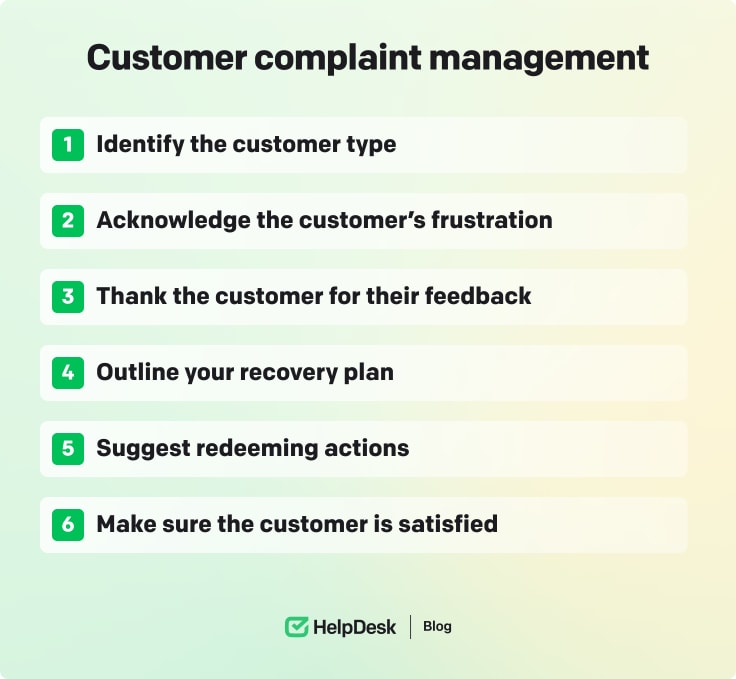
Providing support in multiple languages
Of course, not all customer queries will come in English. The internet has allowed the possibility of global reach, but it’s up to you to make it work for your business. One way you can do this is by smashing the language barriers.
Customers come from around the world, but some speak different languages. Sometimes, you might hit a demographic that shows a particular interest in your services, so you want to cater to them as much as possible. Implementing a multilingual customer service support channel will do just that. Customers are particularly fond of this feature and often mention it in their reviews, which will help sway potential customers who are still considering your service.
While automatization has greatly helped in this field, you can use other effective techniques. For instance, look for team members who speak multiple languages and can address customer support requests adequately. Additionally, you can help individuals create language models, making the chat systems more sophisticated and efficient.
Using AI to enhance customer service
AI has changed how the world works, and social media customer service is no exception. As you can imagine, AI tools revolutionized automation and made the business run more efficiently. In our case, customer service teams use AI-backed technologies to scale functions, deliver proactive responses, and ensure all customer inquiries and requests have been answered correctly.
You can implement this technology in many ways to improve your business’s workflow. For one, you can develop chatbots, which we’ve already touched on. Another way AI can help is by helping you find the appropriate brand voice. Specific tools, such as Grammarly, have a built-in writing interface that corrects your grammar and gives you prompts or suggestions to sound more positive, energetic, formal, and so forth.
Finally, AI can also perform some assessments, but they must be double-checked for relevance. These technologies can read customer messages and their tone, detecting whether the customer sounds happy, angry, or anything in between. By doing so, AI can prioritize the most important queries based on the customer’s voice and further help your customer service team with their approach.
How to measure and report on your efforts
After establishing your social media customer service, your work continues beyond there. Before reaping all the benefits, you must tweak your strategy and monitor your performance regularly. Note that progress doesn’t happen overnight, as customers don’t usually face many issues. Still, once they arise, you need to look into the communication used, how long the customers were retained, and the time it took to resolve their issue. On top of that, monitoring your KPIs is of utmost importance.
Let’s start with communication, the core of your strategy. Even if you’re going for a fully automated approach, there are still many ways you can personalize your messages and make your customers feel like they’re talking to a real human instead of a bot. For one, you can have the customer’s name written out at the end of the message, providing the feeling of a more personalized service. Additionally, you should respond to almost everything, even if it’s a bunch of comments on meme social media posts. Of course, you should do this by redirecting them to the appropriate channel. Finally, the most important thing is to answer questions and concerns as quickly as possible. Remember — the faster you are, the more points you score.
From here, you’ll start monitoring your progress occasionally. While focusing on the details, you should always look back to the bigger picture, whether it complies with your initial idea of social media customer service. If specific patterns are less regular, you’ll know you’re taking all the steps in the right direction. In contrast, having the same issues appear repeatedly may signify you have an internal issue with your customer service reps.
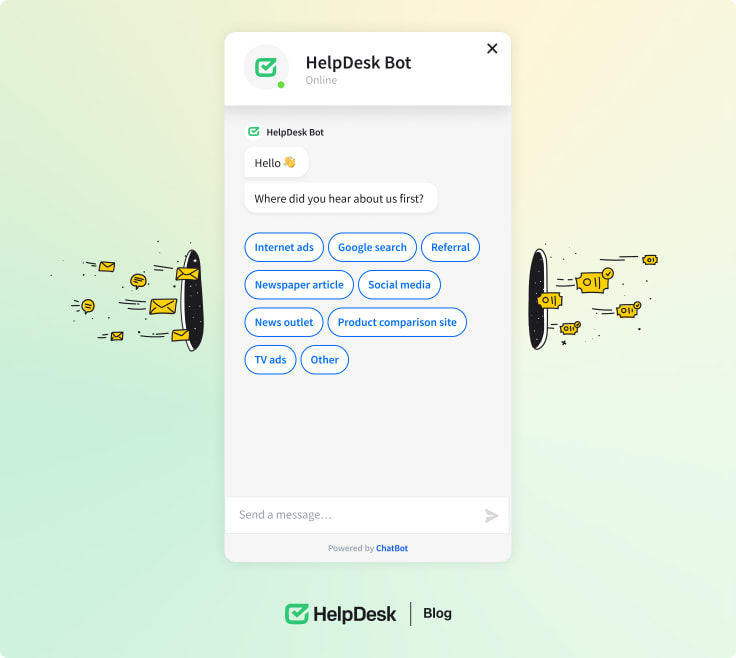
Using metrics to improve your social media customer service
Finally, some techniques will help you improve your social media customer service with the help of your metrics.
You already know that not all communication results in customer engagement. That is why you should consider using various communication methods to make your customers stay with you. For example, some customers may respond best to comments, discounts, and giveaways while showing no interest in your e-mail newsletter.
Normally, if the newsletter provides any service, you don’t need to focus on its improvement. On the contrary, you should utilize the techniques that are proven to work and optimize them to bring ideal results. However, be careful with overdoing them. Your customers may feel overwhelmed, making your best technique ineffective.
Of course, you must also look into the logistics. I mentioned KPIs. Aspects like first contact resolution, response time, complaint escalation rate, and customer retention should be identified and measured in detail so you can tweak your social media customer service. The more data you collect, the more informed you’ll be about your key performance.
Last but not least, ask your customers for their opinions. Indeed, you can easily do this by adding a comment-centric CTA in your social media posts, but sometimes, it’s wise to take a deep dive into the matter. You can easily do this by creating online surveys where previous customers can assess your performance, highlighting your strengths and weaknesses. You should also establish reach with these surveys to know all areas your business can improve.
Explore more customer service metrics with HelpDesk. Read our lesson, Key Metrics for Measuring Customer Support. 🦸
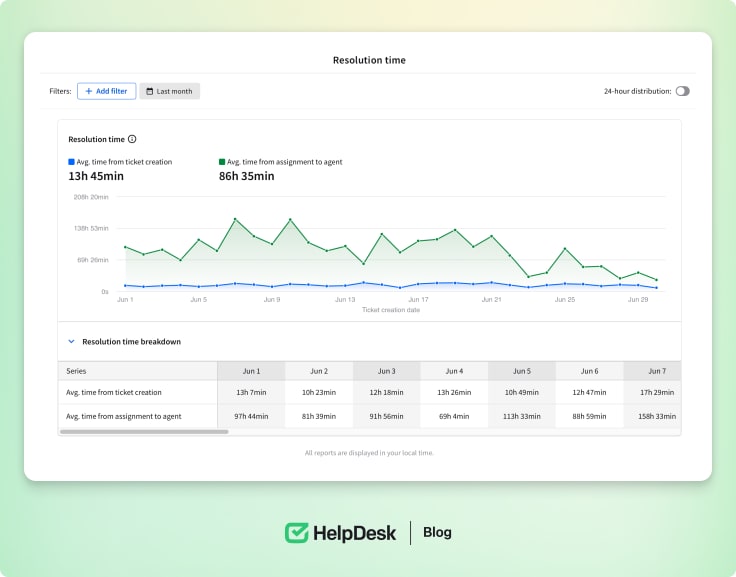
Real-world examples of excellent social media customer service
Adobe
Adobe has one of the best social media customer service strategies. Whenever customers need help, they can simply head to any of their social media platforms, where they’re just a click away from accessing the support system. Users can easily navigate their extensive menus, eliminating the need for a real rep.
To make things even better, Adobe frequently offers coupon codes and hosts giveaways for their users. This is a great way to attract potential customers and has proven to be quite a success for the tech giant. Adobe has also designed its social media channel based on streaming game competitions, making it highly engaging with customers.
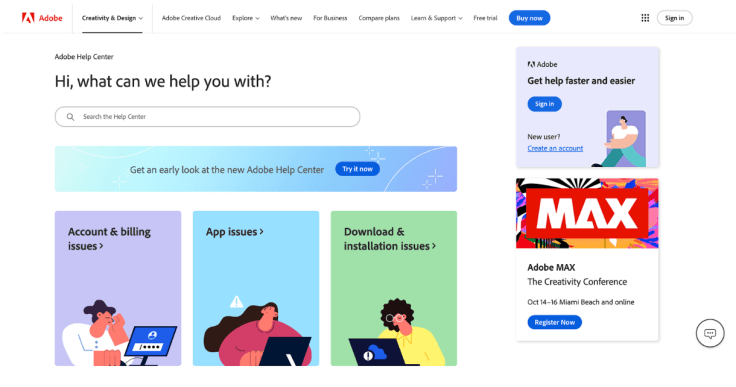
MAC Cosmetics
Major beauty brands had to bring out the big guns and score celebrity endorsements to promote their products. Now, they can achieve the same result by commenting a few words on their customer’s video reviews.
MAC Cosmetics’ TikTok is a perfect example of this. You’ll see tons of user videos on their page reviewing their products. As you know, real-time reviews are the best, scoring major points for MAC’s brand image. Additionally, since the customer is rather excited about having their work reshared, they’re more likely to purchase the brand’s products time and time again.
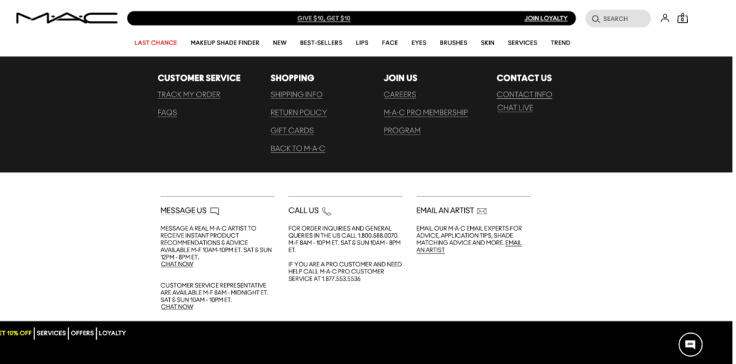
Spotify
Spotify is known to feature occasional bugs, but luckily, they’re handled in minutes. Users must contact the streaming service’s X support handle whenever they face an issue.
The automated bot will either direct them to the appropriate page for the issue they’re facing or a contact form where they can explain their issue in detail.
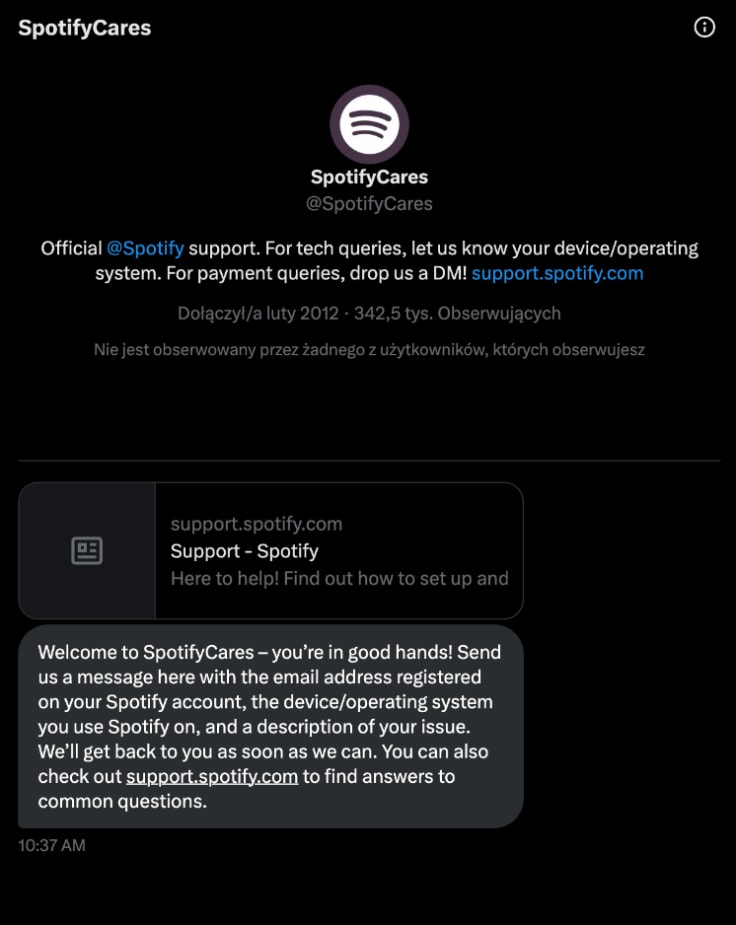
Brastel
One of the many ways HelpDesk has helped businesses is by automating ticket handling. Brastel, a Tokyo-based telecommunication business, is a prime example of this. Over 25 years in the industry, they saw how customer service changed.
However, social media customer service was the only way they saw significant improvements in their workflow. Using HelpDesk, Brastel can now handle over 2000 tickets per month.

Summary
Social media customer service will undoubtedly take your business to new heights. Having your client’s issues and concerns in one place will allow you to communicate with them more easily. The appropriate social support team will handle their various queries, saving you time and money and building up your image as a reputable brand.
You already know that HelpDesk is your go-to solution for easily implementing social media customer service. That’s why we invite you to explore our desk system software and see how our services can take your business to the next level.
And since you may face some blunders from time to time, we prepared a nifty HelpDesk Handbook for these cases that covers the essentials and completes the setup in minutes.



